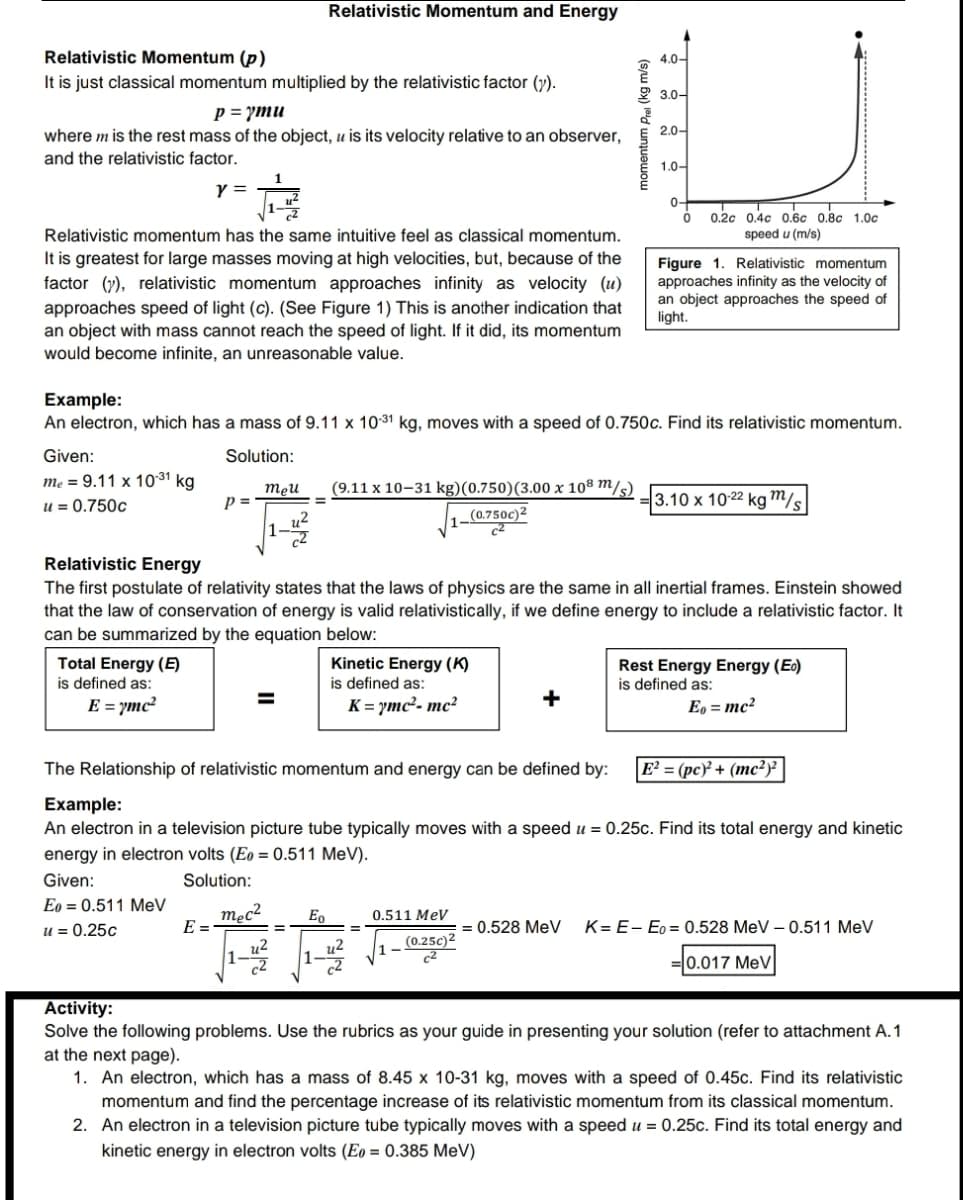An electron, which has a mass of 8.45 x 10-31 kg, moves with a speed of 0.45c. Find its relativistic momentum and find the percentage increase of its relativistic momentum from its classical momentum. An electron in a television picture tube typically moves with a speed u = 0.25c. Find its total energy and kinetic energy in electron volts (Eo = 0.385 MeV)
An electron, which has a mass of 8.45 x 10-31 kg, moves with a speed of 0.45c. Find its relativistic momentum and find the percentage increase of its relativistic momentum from its classical momentum. An electron in a television picture tube typically moves with a speed u = 0.25c. Find its total energy and kinetic energy in electron volts (Eo = 0.385 MeV)
College Physics
1st Edition
ISBN:9781938168000
Author:Paul Peter Urone, Roger Hinrichs
Publisher:Paul Peter Urone, Roger Hinrichs
Chapter28: Special Relativity
Section: Chapter Questions
Problem 72PE: Construct Your Own Problem Consider an astronaut traveling to another star at a relativistic...
Related questions
Question

Transcribed Image Text:Relativistic Momentum and Energy
Relativistic Momentum (p)
It is just classical momentum multiplied by the relativistic factor (y).
4.0-
2 3.0-
p = ymu
2.0-
where m is the rest mass of the object, u is its velocity relative to an observer,
and the relativistic factor.
1.0-
1
Y =
0-
0.2c 0.4c 0.6c 0.8c 1.0c
Relativistic momentum has the same intuitive feel as classical momentum.
speed u (m/s)
It is greatest for large masses moving at high velocities, but, because of the
factor (7), relativistic momentum approaches infinity as velocity (u)
Figure 1. Relativistic momentum
approaches infinity as the velocity of
an object approaches the speed of
light.
approaches speed of light (c). (See Figure 1) This is another indication that
an object with mass cannot reach the speed of light. If it did, its momentum
would become infinite, an unreasonable value.
Example:
An electron, which has a mass of 9.11 x 10-31 kg, moves with a speed of 0.750c. Find its relativistic momentum.
Given:
Solution:
me = 9.11 x 1031 kg
u = 0.750c
meu
(9.11 x 10-31 kg)(0.750)(3.00 x 108 m/s)
p =
3.10 x 1022 kgm/s
/1-(0.750c)²
c2
u2
Relativistic Energy
The first postulate of relativity states that the laws of physics are the same in all inertial frames. Einstein showed
that the law of conservation of energy is valid relativistically, if we define energy to include a relativistic factor. It
can be summarized by the equation below:
Total Energy (E)
is defined as:
Kinetic Energy (K)
is defined as:
K = ymc²- mc²
Rest Energy Energy (Eo)
is defined as:
%3D
E = ymc²
E, = mc²
The Relationship of relativistic momentum and energy can be defined by:
E = (pc) + (mc²)²
Example:
An electron in a television picture tube typically moves with a speed u = 0.25c. Find its total energy and kinetic
energy in electron volts (Eo = 0.511 MeV).
Given:
Solution:
Eo = 0.511 MeV
męc2
Eo
0.511 MeV
u = 0.25c
E =
= 0.528 Mey
K= E- Eo = 0.528 MeV – 0.511 MeV
u2
(0.25c)2
|0.017 MeV
Activity:
Solve the following problems. Use the rubrics as your guide in presenting your solution (refer to attachment A.1
at the next page).
1. An electron, which has a mass of 8.45 x 10-31 kg, moves with a speed of 0.45c. Find its relativistic
momentum and find the percentage increase of its relativistic momentum from its classical momentum.
2. An electron in a television picture tube typically moves with a speed u = 0.25c. Find its total energy and
kinetic energy in electron volts (Eo = 0.385 MeV)
momentum Prel (kg m/s)
Expert Solution
This question has been solved!
Explore an expertly crafted, step-by-step solution for a thorough understanding of key concepts.
This is a popular solution!
Trending now
This is a popular solution!
Step by step
Solved in 2 steps with 2 images

Knowledge Booster
Learn more about
Need a deep-dive on the concept behind this application? Look no further. Learn more about this topic, physics and related others by exploring similar questions and additional content below.Recommended textbooks for you

College Physics
Physics
ISBN:
9781938168000
Author:
Paul Peter Urone, Roger Hinrichs
Publisher:
OpenStax College

Physics for Scientists and Engineers with Modern …
Physics
ISBN:
9781337553292
Author:
Raymond A. Serway, John W. Jewett
Publisher:
Cengage Learning

Principles of Physics: A Calculus-Based Text
Physics
ISBN:
9781133104261
Author:
Raymond A. Serway, John W. Jewett
Publisher:
Cengage Learning

College Physics
Physics
ISBN:
9781938168000
Author:
Paul Peter Urone, Roger Hinrichs
Publisher:
OpenStax College

Physics for Scientists and Engineers with Modern …
Physics
ISBN:
9781337553292
Author:
Raymond A. Serway, John W. Jewett
Publisher:
Cengage Learning

Principles of Physics: A Calculus-Based Text
Physics
ISBN:
9781133104261
Author:
Raymond A. Serway, John W. Jewett
Publisher:
Cengage Learning

Physics for Scientists and Engineers
Physics
ISBN:
9781337553278
Author:
Raymond A. Serway, John W. Jewett
Publisher:
Cengage Learning

Physics for Scientists and Engineers, Technology …
Physics
ISBN:
9781305116399
Author:
Raymond A. Serway, John W. Jewett
Publisher:
Cengage Learning

College Physics
Physics
ISBN:
9781285737027
Author:
Raymond A. Serway, Chris Vuille
Publisher:
Cengage Learning